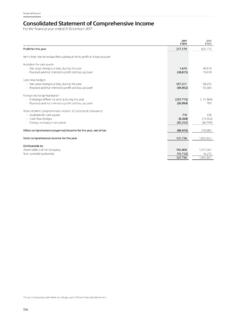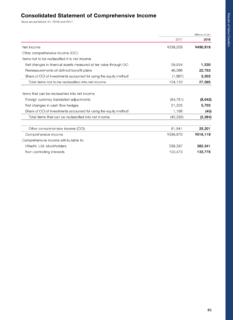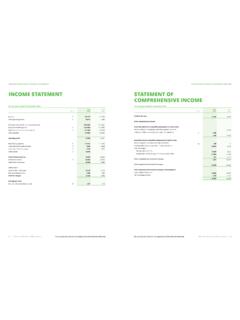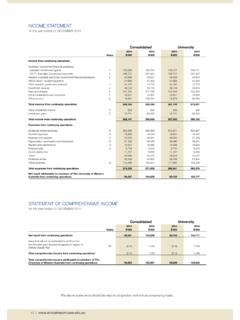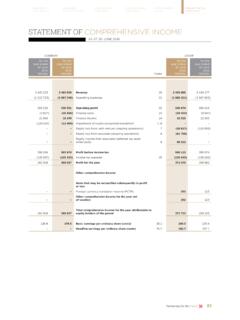Transcription of Chapter 4 The Income Statement, Comprehensive Income, …
1 Solutions Manual, , Chapter 4 4 1 Copyright 2018 McGraw-Hill Education. All rights reserved. No reproduction or distribution without the prior written consent of McGraw-Hill Education. Question 4 1 The Income statement is a change statement that reports transactions revenues, expenses, gains, and losses that cause owners equity to change during a specified reporting period. Question 4 2 Income from continuing operations includes the revenue, expense, gain, and loss transactions that will probably continue in future periods. It is important to segregate the Income effects of these items because they are the most important transactions in terms of predicting future cash flows. Question 4 3 Operating Income includes revenues and expenses and gains and losses that are directly related to the principal revenue generating activities of the company.
2 Nonoperating Income includes items that are not directly related to these activities. Question 4 4 The single-step format first lists all revenues and gains included in Income from continuing operations to arrive at total revenues and gains. All expenses and losses are then grouped and subtotaled, subtracted from revenues and gains to arrive at Income from continuing operations. The multiple-step format reports a series (multiple) of intermediate totals such as gross profit, operating Income , and Income before taxes. Very often Income statements adopt variations of these formats, falling somewhere in between the two extremes. Chapter 4 The Income Statement, Comprehensive Income , and the Statement of Cash Flows QUESTIONS FOR REVIEW OF KEY TOPICS 4 2 Intermediate Accounting, 9/e Copyright 2018 McGraw-Hill Education.
3 All rights reserved. No reproduction or distribution without the prior written consent of McGraw-Hill Education. Answers to Questions (continued) Question 4 5 The term earnings quality refers to the ability of reported earnings ( Income ) to predict a company s future earnings. After all, an Income statement simply reports on events that already have occurred. The relevance of any historical-based financial statement hinges on its predictive value. Question 4 6 Restructuring costs include costs associated with shutdown or relocation of facilities or downsizing of operations. They are reported as an operating expense in the Income statement. Question 4 7 The process of intraperiod tax allocation matches tax expense or tax benefit with each major component of Income , specifically continuing operations and any item reported below continuing operations.
4 The process is necessary to achieve the desired result of separating the total Income effects of continuing operations from any discontinued operations and also to show the after-tax effect of discontinued operations. Question 4 8 The net-of-tax Income effects of a discontinued operation must be disclosed separately in the Income statement, below Income from continuing operations. The Income effects include Income (loss) from operations and gain (loss) on disposal. The gain or loss on disposal must be disclosed either on the face of the statement or in a disclosure note. If the component is held for sale but not sold by the end of the reporting period, the Income effects will include Income (loss) from operations and an impairment loss if the fair value less costs to sell is less than the book value of the component s assets.
5 The Income (loss) from operations of the component is reported separately in discontinued operations on prior Income statements presented for comparative purposes. Solutions Manual, , Chapter 4 4 3 Copyright 2018 McGraw-Hill Education. All rights reserved. No reproduction or distribution without the prior written consent of McGraw-Hill Education. Answers to Questions (continued) Question 4 9 A change in accounting principle refers to a change from one acceptable accounting method to another. The various approaches chose by the FASB to require implementation by companies include: 1. Retrospective approach. The new standard is applied to all periods presented in the financial statements. That is, we restate prior period financial statements as if the new accounting method had been used in those prior periods.
6 We revise the balance of each account affected to make those statements appear as if the newly adopted accounting method had been applied all along. 2. Modified retrospective approach. The new standard is applied to the adoption period only. Prior period financial statements are not restated. The cumulative effect of the change on prior periods' net Income is shown as an adjustment to the beginning balance of retained earnings in the adoption period. 3. Prospective approach. This approach requires neither a modification of prior period financial statements nor an adjustment to account balances. Instead, the change is simply implemented in the current period and all future periods. Question 4 10 A change in accounting estimate is accounted for in the year of the change and in subsequent periods; prior years financial statements are not restated.
7 A disclosure note should justify that the change is preferable and should describe the effect of a change on any financial statement line items and per share amounts affected for all periods reported. 4 4 Intermediate Accounting, 9/e Copyright 2018 McGraw-Hill Education. All rights reserved. No reproduction or distribution without the prior written consent of McGraw-Hill Education. Answers to Questions (continued) Question 4 11 Prior period adjustments are accounted for by restating prior years financial statements when those statements are presented again for comparison purposes. The beginning of period retained earnings is increased or decreased on the statement of shareholders equity (or the statement of retained earnings) as of the beginning of the earliest period presented.
8 Question 4 12 Earnings per share (EPS) is the amount of Income achieved during a period for each share of common stock outstanding. If there are different components of Income reported below continuing operations, their effects on earnings per share must be disclosed. If a period contains discontinued operations, EPS data must be reported separately for Income from continuing operations, discontinued operations, and net Income . Question 4 13 Comprehensive Income is the total change in equity for a reporting period other than from transactions with owners. Reporting Comprehensive Income can be accomplished with a continuous statement of Comprehensive Income that includes an Income statement and other Comprehensive Income items or in two statements, an Income statement and a separate statement of Comprehensive Income .
9 Question 4 14 The purpose of the statement of cash flows is to provide information about the cash receipts and cash disbursements of an enterprise during a period. Similar to the Income statement, it is a change statement, summarizing the transactions that caused cash to change during a particular period of time. Solutions Manual, , Chapter 4 4 5 Copyright 2018 McGraw-Hill Education. All rights reserved. No reproduction or distribution without the prior written consent of McGraw-Hill Education. Answers to Questions (continued) Question 4 15 The three categories of cash flows reported on the statement of cash flows are: 1. Operating activities Inflows and outflows of cash related to the transactions entering into the determination of net Income from operations.
10 2. Investing activities Involve the acquisition and sale of (1) long-term assets used in the business and (2) nonoperating investment assets. 3. Financing activities Involve cash inflows and outflows from transactions with creditors and owners. Question 4 16 Noncash investing and financing activities are transactions that do not increase or decrease cash but are important investing and financing activities. An example would be the acquisition of property, plant, and equipment (an investing activity) by issuing either long-term debt or equity securities (a financing activity). These activities are reported either on the face of the statement of cash flows or in a disclosure note. Question 4 17 The direct method of reporting cash flows from operating activities presents the cash effect of each operating activity directly on the statement of cash flows.





